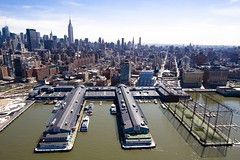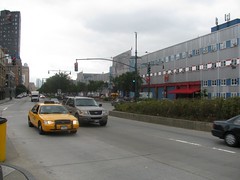Chelsea Piers

A waterfront complex designed by Warren & Wetmore and opened in 1910, these piers were a major hub for both freight and passenger liners; many immigrants actually docked here first before being taken by ferry to Ellis Island. Troops departed from here to the European front in both world wars.

As passengers took to the air and freight traffic shifted to New Jersey, the Chelsea Piers declined, until by the 1980s they were almost demolished for the West Side Highway project. When that fell through, the piers were turned over to a private entity, Chelsea Piers Management, for development into a sports complex--which opened in stages starting in 1995.
Pier 61
Features the Sky Rink, an ice rink so-called because it was formerly located atop the Westyard Distribution Center at 10th Avenue and 31st Street. Features hockey, figure skating and general skating.Silver Screen Studios, located here, was used to shoot such films as You've Got Mail, Big Night and Everyone Says I Love You, as well as TV shows like Law and Order, Special Victims Unit and Spin City.